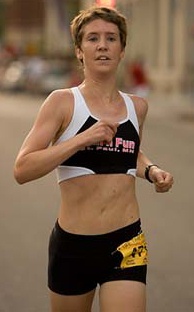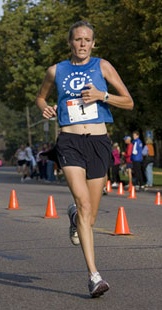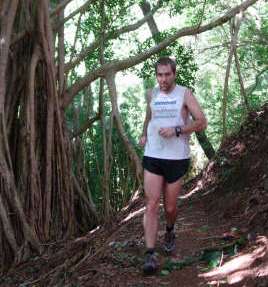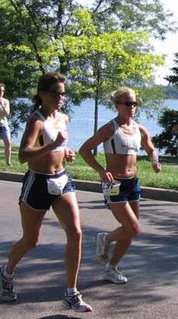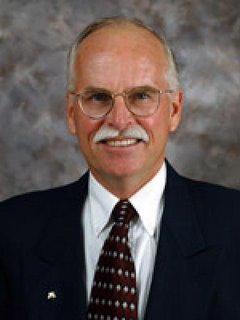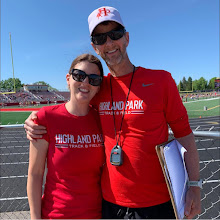 This interview is dedicated to my friend Scott who said to me a couple of weeks ago, "You should interview Steve Hoag." I thought, "Great idea, Scott. Let me call up my good buddy, Bill Rodgers, and get his phone number." Well, no need to call Bill, as I came across Steve's contact info on a "world famous" running forum. With clues like; 2:11 marathoner, from Minneapolis, owned a running store, I was pretty sure it was THE Steve Hoag. This one may take awhile to get through - but it's well worth it! (All photos courtesy of Steve Hoag; Steve Hoag running in Theodore Wirth Park)
This interview is dedicated to my friend Scott who said to me a couple of weeks ago, "You should interview Steve Hoag." I thought, "Great idea, Scott. Let me call up my good buddy, Bill Rodgers, and get his phone number." Well, no need to call Bill, as I came across Steve's contact info on a "world famous" running forum. With clues like; 2:11 marathoner, from Minneapolis, owned a running store, I was pretty sure it was THE Steve Hoag. This one may take awhile to get through - but it's well worth it! (All photos courtesy of Steve Hoag; Steve Hoag running in Theodore Wirth Park)Obviously, you’re best known for your 2:11:54 second place finish at the 1975 Boston Marathon. I believe your PR heading into that race was “only” 2:16. What were your expectations for the race?
I cranked up my training in quality and quantity, shooting for the works at Boston in 1975. At Boston you are never sure of the field, only that it’ll be tough. Based on a 2:16 6th place finish in ’74, I wanted “top 5” and thought WINNING was a distinct possibility if I could run 2:12. Ron Daws agreed, and he knew my ability better than I did (e.g., moments before the ’74 race, he told me he thought I’d run 2:17. I ran 2:16:44. Ron, like most people, thought a 2:12 SHOULD win.
I increased mileage, topping out at 90-plus miles for a few weeks, and ran the hill workouts fiercely. Good quality, longer intervals were done using ladders; 440 yards to mile and down, 10 x mile at 4:50-5:00 pace, depending on the interval. I got a LOT of help from my Twin Cities Track Club teammates (Garrett Tomczak in particular) who would run partials of the mile repeats or every other one. Daws and others helped with the 25-30 mile long runs. I was ready to go by mid-April!! That winter was especially brutal for running, which I believe helped n my base building and long runs. We had a tremendous cardio effect happening without realizing it!
What are some of your other accolades that you’re most proud of?
One of my proudest moments came from winning the Big 10 two-mile (Indoors). I dreamed of being a Big Ten Champ and getting under 9-minutes, which was the “holy grail” for most college distance men in that era. I accomplished both in 1969 by winning in 8:57 with 4:36/4:21 splits! Considering my mile PR wasn’t much faster, and that there were several 4:05 mile guys in the field, it was a very satisfying win. It was a race I probably shouldn’t have won, but I threw in a 61-second fifth 440y to catch the speedy guys napping!
Another race that comes to mind is the 1968 NCAA 10,000m where I placed 3rd (won by Gerry Lindgren) and made All-American! Steve Hoag, from Anoka, MN, a track All-American!!?? Also meaningful to me was that I beat several big name collegiate distance runners and I got invited to the 1968 OLYMPIC TRIALS at Lake Tahoe!!
Probably my last good race, the ’75 Springbank 12 mile in London, Ontario, which had incredibly good fields. In 1975 the field consisted of none other than Frank Shorter, Bill Rodgers, Jerome Drayton and 2 other Boston Marathon winners, plus England’s great Ian Thompson. It was a “balls-to-the-wall” fast pace as we came by “3 miles” (actually it was a little short) in 13:45. It was frightening because my 3 mile PR was 13:52 – and I still had 3 more of those to go. I ended up placing 5th. A great time and a lot of fun.
Captaining the Gopher cross-country team to its best finish ever (4th place) at the ’68 NCAAs also comes to mind, along with being inducted into the Minnesota Track and Field Hall of Fame. That was very gratifying. It validated my running career by my peers. At the time (2000), I think that only about 35 individuals were in the HoF. I was very honored!
Finally, being ranked 4th in WORLD for the marathon in 1975 by Track & Field News was a great honor.
What are your other PRs?
Yawn!
Track: 880 yards – 1:57, 1 mile – 4:12, 2 miles – 8:57, 3 miles – 13:52, 6 miles – 29:03, 10 miles – 49:51.
My track PRs were all done in 1968-69, at age 21. Regrettably, I never raced seriously on the track after that.
Roads: 5 miles – 23:45, 7 miles – 34:59, half marathon – 1:06, marathon – 2:11:54. I’ve had other, faster, road times, but they were questionable for accuracy.
You sold your store (Marathon Sports) a couple of years ago. Does that mean you’re retired? What are you up to nowadays (working, running, etc.)?
I’m retired, but still pretty busy with hobbies. Believe it or not my hobbies are as diverse as: restoring old classic cars (I have a ’55 Chevy BelAire and a ’65 Mustang convertible…oh yeah), restoring old motorcycles, scooters, bicycles, rehabbing old houses, collecting metal toy cars from the 1900-1950s. My wife (of 35 years), Jeri, and I do lots of stuff together too. Plus, we just became grandparents, so we're looking forward to that.
My “running” is based on the “gentleman’s 3”: slow, easy running for 3 miles, usually on trails or grass.
You’re also coaching cross-county. Are your athletes aware of your running accomplishments?
I coach x-c at Richfield H.S., which I really enjoy. The kids know about my running background, but I don’t believe they can reconcile “Coach Steve” and running a 2:11 marathon. It’s funny though, last year at Twin Cities Marathon water stop, where the team volunteered, one of them asked in dead earnestness, “Steve, if you started really training, you could win this, couldn’t you?” Kids just don’t realize that a 58 year old man with a bad back will probably not win the TCM, no matter how fast he had run 30 years ago. Bless their hearts.
You were interviewed in October 2002 and one of the questions was about the current state of U.S. distance running. You said, “It goes in cycles and I think we are going to see it [U.S. runners being competitive on the world stage] again.” Since then we’ve collected a couple of Olympic medals and, more recently, Ryan Hall set an American Record for the half marathon. Based on comments you’ve made, I assume you attribute this to the elite training groups that are set up around the country?
Most definitely, the recent popularity of the elite training groups has fueled this resurgence in U.S. distance running. Meb Keflezighi and Deena Kastor at Athens, the 2006 Boston Marathon, and Ryan Hall, Andrew Carlson, Jason Lehmkuhle and others this month in the Houston Half Marathon. The current training sites/clubs are similar to training in the ‘70s with more structure, some money and the inclusion of women.
There really is no mystique as to why there was so much success by U.S. distance running: love of running, pure hard work that was made enjoyable by the group effort. Also the success starting in the mid-60s with Buddy Edelen, Gerry Lindgren, Bob Schul, Billy Mills, etc. and Frank Shorter at Fukuoka and Munich. Success begets success; we started believing in ourselves. We’re getting there again!
I’ve been doing some research for another project by looking through some MDRA newsletters from the early ‘70s and a few things stand out to me; First, “you guys” ran a lot of events that you don’t see any more; 1-hour races, 10-mile races on the track, 24-hour relays where teams of 10 alternated running mile repeats, etc. What are your thoughts on some of these events and how they compare to today’s race schedule?
There were indeed some interesting races in the ‘70s that probably wouldn’t catch on today. In 1973, for example, a typical race had 20-50 (mostly male) runners. You could work the finances to make races of that size work, as they were held at tracks and parks. Today it costs $3,000-10,000 to close down Lake Harriet for a 5K. Tracks, for liability reasons, are often hard to use. Today, races are huge and are mostly a big business.
I particularly liked the 10-mile track races. Each runner had to bring a person to count all 40 laps. I sometimes hated 10,000m on the track, but a 10-mile track race was “fun.” Go figure. Probably because a 10K is faster and more intense; a track 10-mile allows a slower, more manageable pace. I ran 49:51 at Macalester’s track in ’68 and I recall it being almost hypnotic.
Another example was the two-person 10-mile relay. You partnered with someone close to your ability and you each took turns running 20 x 440y at 60-65 second pace.
I never was intrigued that much with running a 24-hour relay with mile repeats. I guess I valued my sleep too much. They were popular for a few years, and a post-collegiate team from Minnesota did extremely well one year.
Also postal races (where you submitted your results through the mail to a national coordinator who would send out final results later to all the clubs involved) were somewhat popular. “Last person-out” races were fun to watch and run on the track. Handicap 10-mile races were interesting, also. There’s nothing like spotting someone a half hour and then trying to beat them. Pat Lanin, who ruled over road-racing events in -the ‘60s and early-70s, was great. Pat should be given TONS of credit for what he and his wife Emily did for Minnesota distance running.
Second, I just assumed guys like you, Ron Daws and Garry Bjorklund were winning every race around. However, while you won your fair share, there were a lot of other guys (Tom Hoffman, LaVerne Dunsmore, Chuck Burrows, Glen Herold, Chuck Ceronsky, Don Timm, etc.) winning too. Is that mainly a testament to the depth of the running scene at that time?
Yes, winning was pretty spread out, due to the talent here! No one could really dominate, except possibly Garry “BJ” Bjorklund, who was good at everything from 1 mile to marathon. BJ didn’t race much locally though.
There were some guys who were better at 5 mile and shorter (Don Timm and Mike “Slicker” Slack). Some were good at the difficult events like the Mudball (Ceronsky). Burrows and myself were good at 10 miles and up. Hoffman and Herold were actually from Wisconsin, but they raced well over here. Interestingly, for every name you mentioned here, I can come up with 3, 4, 5 names equally as good; Garrett Tomczak, Bruce Mortenson, Jim Ferstle, Dennis Barker, Mike Seaman, Van Nelson, etc., etc. Nelson was totally phenomenal but his career was over by 1969.
Incredible talent in this area at that time, and DEEP!! Women runners were represented by Jan Arenz, Val Rogosheske, Alex Boies, Jill Hanson (UM’s Ben Hanson’s mom). All were nationally ranked or recognized. Marathon World record-holder Cheryl Bridges later trained here (with the guys, no less). Lorraine Moller (New Zealand medalist in the marathon) trained with us while married to Daws. Later Janis Klecker, Jan Ettle, Bev Docherty would do well at the Trials and Olympics (Klecker).
While you’re in-tune with what’s going on nationally, are you aware that some of the guys you ran against, like Alan Gilman and Jeff Reneau now have kids (Pete and Michael, respectively) that are now tearing up the roads and have qualified for the Olympic Trials Marathon?
Yes, I have met Jeff’s son, Michael, and he looks like he is better than his old man was, and he was tough! I ran against Jeff for a few years and he wouldn’t give an inch in a race. I raced against Al a few times too and he was very solid. I KNOW his son Pete is good because when I was with Marathon Sports, I sent him a check for racing so well at TCM. It’s fun to see the kids are taking after their “ol men.”
Do you look at the results for your current age-group and were there ever any thoughts of a “comeback,” even at the age-group level?
I occasionally look at the age group stuff, and find it interesting that a lot of elite age groupers were not that active/good in or after college. It seems that a lot of them took up racing in their later years with “fresh legs”. Most of us are pretty “dormant” now, regarding high level racing. There are always a few exceptions, but it’s very hard to maintain the drive to compete at a high level for a long time. I still love “running” but my ego and pride will not allow me to compete. If I ever get thoughts of a comeback, I wait until they pass.
What was like to be a runner in the Twin Cities, prior to the running boom? Reading some of Hal Higdon’s early writings, it sounds like you had a better chance of being arrested for “suspicious behavior” while running, than actually seeing another runner on the roads. It’s hard to picture the lakes or river roads without a large number of runners on them.
I can remember running in my hometown of Anoka, and well-meaning neighbors, friend, etc. would stop their cars and ask if I needed help. “Gee, you’re running for NO reason?” I believe Anoka and Minneapolis cops talked to me on a few occasions. I got into an argument with a Minneapolis policeman once because I was running 5:00 mile repeats on West River Road and he didn’t want me “jogging” on the road. He pulled me in to the squad car and was going to bust me, but he chickened out a block from the station. Looking back now, it does seem strange that so many miles were run on the roads. Now we have nice paths around the lakes, river road, etc. Back then, we were indeed ROAD runners or sidewalk runners. There was a path around the lakes, but we didn’t use it much. I think we raced on the roads, so it made sense to train on them too.
I’m always curious what the “Old School” runners think about all the training terminology (lactate threshold, anaerobic threshold, tempo runs, heart rate monitors and the different zones, etc.) that gets thrown around now-a-days?
I admit I break out into a cold sweat when I hear terms like lactate and anaerobic threshold. We had days when we ran very hard for varying distances, we had intervals – long and short, we had long aerobic days of 15-30 miles and we had easy “filler” days to rest and help get our mileage totals up. We were just not real scientific about it.
We followed a basic Lydiard program of base (easy) LSD for about 6 weeks, transitioned into hills and distance, and finally transitioned into intervals and racing. Distance dropped as you entered the racing phase. There was the old maxim that you can’t race AND train at the same time. We raced until you could almost sense you were losing condition, desire, or both. We would take a 2-3 week rest period, usually in November or December, and then start again from scratch.
Depending on what you were training for, there were about 2 cycles per year. The other rest period might be in June if you ran Boston in April. After a rest period, you could start another cycle for fall. That was always secondary to me, as Boston was my focus most of those years.
Daws was probably the epitome of “Old School” regarding shoes and clothing, but he was using a heart rate monitor toward the end of his life. He didn’t use it every day, but found that he wasn’t running hard enough DOWN hills and needed to run harder to keep his HR up. Conversely, he was revving too high on the uphill portion, so he slowed down to keep his HR in the target zone. He also MADE a crude treadmill for his basement, with music piped in. It was a butt-ugly contraption, but Ron would use it very occasionally to run 10 x “mile” repeats if he couldn’t get into the UM Fieldhouse.
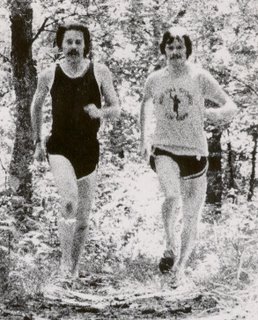 Of course, I have to ask about Ron Daws. Someone recently told me that he was the kind of guy that no matter what kind of mood you were in, you were in a better one after talking with Ron. Would you agree? (Photo of Ron Daws and Steve Hoag in Theodore Wirth Park)
Of course, I have to ask about Ron Daws. Someone recently told me that he was the kind of guy that no matter what kind of mood you were in, you were in a better one after talking with Ron. Would you agree? (Photo of Ron Daws and Steve Hoag in Theodore Wirth Park)I would need 100 pages or more to ADEQUATELY describe Ron Daws. He was without a doubt the most complex and genuine person I have ever known. He was also perplexing and contradictory; extremely outgoing most of the time, barrel of fun, incredible wit, and yet, he could be very reclusive and private for seemingly no reason. He was very approachable, yet at times, he could resent his privacy being compromised. Most of the time though, Ron liked to help anyone interested in the sport he truly loved.
I always thought it spoke well of Ron that he could run in the Olympic Games Marathon and a week or two later, run in some rinky-dink all-comers race and come in 5th or 6th place. He didn’t mind. He always ran hard – whether he was in Mexico City or Mankato.
It would have been very easy for Ron to become jealous of my success at Boston, after he dominated the local, regional, and national running scene. I represented the “changing of the guard,” as I was 10 years younger. He not only accepted that, he relished the idea of coaching/advising me. He loved to share his knowledge of running and I soaked up every tidbit Ron gave from clothing/shoe tweaking to training and racing. Although Ron didn’t help me much in my collegiate racing years (Roy Griak sure did), he was the most influential person involving my road racing career. There is absolutely no doubt that I would not have run 2:11 without Ron Daws.
Did he always put you in a better mood after seeing him? Well about 99% of the time he would. Ron’s personality could light up a room. The Minnesota running community got a little darker after Ron died in 1992.
Is there anyone that did a better job of explaining Arthur Lydiard’s program (including Lydiard) than Daws?
No, Ron was a great conduit to Lydiard training. He modified it slightly as needed without losing its essence. For example, Ron did not like hill bounding. He did a little bounding, but not consistently. I do not think that he thought it was absolutely critical. He did Lydiard’s mandatory 100-mile weeks (usually 110-125) for base. He knew that, for some reason, I couldn’t handle 100 mpw, so he modified my program so I could be successful at 75-90 mpw. Nobody really agrees 100% on what Lydiard means all the time, but Ron had it nailed for us. Ron’s books are cult items now; explaining so well his and Arthur’s ideas on distance running and putting them in very enjoyable and understandable terms.
One of my standard questions, to my younger interviewees, is; “If you could run with any Minnesotan, past or present, who would it be?” My thinking is they’ll say something like Steve Hoag, Ron Daws, Garry Bjorklund, etc. That makes me curious to hear whom you would choose.
Present day, Carrie Tollefson comes to mind, as she is so mentally tough and talented. She has dealt with adversity in a remarkable manner. I sort of wrote her off a few years ago when she had the major surgery on her heel. I thought it was the end of a great running career. Mistake! I’m very glad I was wrong. She’s one tough runner! Now, I couldn’t run with her or Katie McGregor…they are way too fast.
Also Bob Kempainen, as I like his understated attitude - the guy just got the job done! Very humble. Also, I think he understood the “big picture” when it came to pointing to a big race (e.g. the 1996 Olympic Trials when Keith Brantly was going to out-kick him). I have never met Bob, but I have heard great things about him.
He’s not a Minnesotan, but Steve Prefontaine comes to mind. Although he was incredibly cocky, it would be very interesting to hear HIS story about the Munich 5000m and what he planned to do about Viren’s kick, and others, at Montreal in ’76. With Pre, it would also be great to tip a few beers after the run, but I would take away his car keys.
Finally, what impact do you think you’ve had on the sport in Minnesota?
I feel fortunate to be a VERY small part of an incredible distance running heritage, starting in about 1960. Think of a long chain; I am ONE of many links to it. My times and performances pale in comparison to MY Minnesota heroes, whom I won’t mention. Garry Bjorklund once paid me a great compliment in a speech he was giving, by saying that I had “raised the bar” in distance running in Minnesota. And Dick Beardsley said he read about my workouts in Ron’s book, The Self-Made Olympian.
If anything can be taken from my running experience it would be: Believe in yourself, work very, very hard and you may find yourself on an Olympic team or on the podium at places like Boston or New York. It can happen! It’s a sport that rewards hard work, perhaps as much as raw talent.
 Rather than ask Steve 50 more questions, I thought it would be easier to comb through his comments from said "world famous" message board and post his comments on various topics. (Steve Hoag's 1968 UM Captain's photo)
Rather than ask Steve 50 more questions, I thought it would be easier to comb through his comments from said "world famous" message board and post his comments on various topics. (Steve Hoag's 1968 UM Captain's photo)ON COLLEGE
I was fortunate to be on some very good track and X-C teams at the U of M in the late ‘60s. We won the Big Ten Outdoor Championship in 1968 (by one point!) and finished 4th at NCAA Cross Nationals at Van Cortland Park ('68). The next year, Garry Bjorklund (BJ) came to Minnesota and continued another string of good U of M teams, winning Big 10 X-C with a 1-2-3 finish (BJ, Don Timm, and Tom Page). If only BJ had been a year older; we would have had an awesome X-C team in 1968. Couldn't have touched Villanova, but we would have been up there.
ON AFRICANS
I feel that I was somewhat fortunate to not have the Africans to contend with in the mid-seventies. The Kenyans and Ethiopians were formidable (to say the least!!) in the late sixties and then basically disappeared for a decade or more. The only African runner of significance was Richard Mabuza of Swaziland in the 1975 Boston; he was in the hunt for about half the race and then faded badly. Also, I am surprised that Abebe Bikila and Mamo Wolde ran poorly at Boston in 1963, possibly due to the cold weather that year. I cannot imagine Abebe Bikila losing to ANYONE, after the way he dominated the Marathon in two Olympics!
I have often wondered how our two greats – Frank Shorter and Bill Rodgers - would have fared against the current Africans (Geb and company). Granted it's tough to compare. Based on times, you would have to give the nod to the current stars. Yet, Frank and Bill were both so tough and competitive, I don't know if I would bet against either. I just read where more than 500 Kenyans ran 2:20 or better by 2006; in the 1970s, sub 2:20 was almost considered world class!! Very humbling.
My old friend and training partner, the late Ron Daws, was a great admirer of Abebe Bikila and often said there was a huge untapped market of distance runners in eastern Africa. This was in the late 1960s! Ron also said that the marathon times would change dramatically when the track guys like Frank Shorter and Garry Bjorklund moved up to the marathon. Not bad forecasting by Ron, as the elite 10,000 guys, up until then, basically spurned the marathon.
ON U.S. RUNNING TODAY
As far as today’s elite U.S. marathoners go, they are very impressive. The 2006 Boston performance was exciting and long awaited. U.S. marathoning goes in cycles like most things: Frank Shorter's gold at Munich set in motion the great U.S. era that lasted a decade or more. Alberto Salazar, Dick Beardsley, Bob Kempainen and others had their days at Boston. Now, largely because of the team-training concept, U.S. distance running is again very respectable. Can they compete with the great African runners? Tough, but we will see.
It seems that the most noticeable factor over the years is hunger (for financial recognition) plus inspiration by a coach or fellow countryman. U.S. elite marathoners in the seventies were for the most part hungry for recognition and inspired by the success of Frank Shorter at Fukuoka and Munich '72. Even prior to that, many of us took a lot of pride in Bob Schul, Bill Dellinger, Billy Mills and Gerry Lindgren (beating those big, bad, older Ruskies!) in 1964. Also, Buddy Edelen's World Record in the Marathon told us maybe we were NOT the embarrassment of the distance world, like we had been. The hunger was there for American runners and we trained like crazy in places like Florida, Boston, California, Oregon, and even in the Twin Cities.
I sense the same thing happening today with our elite runners. The pride is there and they're training together hard in clubs across the country. The Brooks-Hanson group reminds me a lot of the way running was in the 1970s and they are getting results. I see the same scenario locally with Team USA Minnesota, although they are more into 5/10k racing. Katie McGregor showed some great marathon potential recently and could be incredible at that distance when she wants to move up from the 10k. Meb Keflezighi and Deena Drossin certainly showed us that Americans can compete internationally, with their medals in Athens. Let's see if it launches the U.S. into another great distance era.
Ryan Hall's great half marathon performance (59:43 at Houston on January 20th) reminds me a lot of Bill Rodgers’s 2:09:55 American and Course Record at Boston in 1975. We saw a glimpse of Bill's talent in the World X-C's a month earlier with a 3rd place finish. Americans just didn't do that well at that event.
Bill's time sent shockwaves through the national and international running communities! Like Hall's brilliant run, he pulled quite a few other Americans to PRs. Along with Shorter at Munich and Fukuoka, Rodgers began a wave of American distance dominance that lasted into the early '80s.
Watch for young upstarts like Andrew Carlson and Jason Lehmkuhle, Brooks-Hanson guys, and others to pop some great Marathons. Are they guaranteed success at the marathon? Certainly not, but this half marathon performance in Houston, along with Meb's success and experience could usher in a new age of American distance excellence. Can they compete with Kenyans and Ethiopians ("A" teams) in the near future? This race indicates that they can!!
Bob Kennedy's SUB-13 5k was also an incredible breakthrough for U.S. distance running. It's unfortunate that the "wave" did not follow! I have a gut feeling that this IS definitely the beginning of an American resurgence in international distance running. I think that the biggest thing going on right now is getting back to the TEAM/CLUB training concept that existed here in the seventies through early eighties. Teams like GREATER BOSTON and FLORIDA TC are the obvious ones that come to mind, helping to make greater runners such as Bill Rodgers, Bob Hodge, Thomas, Vinny Fleming, and of course Frank Shorter, Jack Bacheler, Jeff Galloway, Misner, Barry Brown, etc, etc. These guys were good to begin with, but the club atmosphere made them a lot better!
In Minnesota, we had the Twin Cities Track Club with Ron Daws as our guru. We all trained harder and ran faster because of the group effect. There were other lesser-known clubs like ours that existed and produced some very good runners. No financial rewards at all; the common goal was for EVERYONE to improve times, usually at the marathon.
Team USA Minnesota and the Brooks-Hansons are on the right track, and we are seeing the results. Here in Minnesota, there is a great training environment, and Andrew Carlson, Jason Lehmkuhle, Matt Gabrielson, and others are seeing great improvements. On the women's side, Carrie Tollefson, Katie McGregor and others are thriving under this concept. It's really 1970s training taken to the next level, with a little more structure, science and money thrown in.
ON GERRY LINDGREN
I have grown up as a runner watching Gerry Lindgren, giving me some inspiration in 1964 when he beat the Russians (We were not supposed to be near them in distance races!). Little did I know that I would be in the 1968 NCAA 10,000m running against Gerry Lindgren. I remembered how he seemingly jogged the first six miles and kicked in the last 376m to notch yet another NCAA title. I hung on for 3rd place in what was my PR. Gerry of course had his big race against very tough runners in the 5,000m and used the 10 probably as a "workout". He won the 5, also.
Gerry certainly had his "ups and downs" in running as we all do; his were just much more noticeable, because his "ups" were so fantastic. Misfortune struck during his two Olympic bids. Billy Mills, I believe, thought that Gerry might have won the 10,000m at Tokyo if not injured, and he was injured prior to the 1968 Olympics/trials. Maybe if he trained a little more cautiously he wouldn't have had those injuries, but that wouldn't be Gerry!
His place in distance running history should be near the top; he changed U.S. attitudes towards distance running that PRE-saged our success in the seventies and eighties. His training was bizarre and I often wonder if the mileage (50 miles/day) he claimed he did was for affect. His training claims did get a lot of attention. Nonetheless, he got U.S. runners believing in themselves and probably training more.
I'm glad that Gerry has finally surfaced and is giving his advice to today's runners. Granted some of it is "hokey"; not everyone can be great if they just believe in themselves. And I'm not sure the best way to train is to run anaerobically for the first mile of a 10 mile run. However, take it from someone who was there, he was the real deal!!!
Lindgren's "message" was basically; “Do the most mileage you can and do not put limits on what you can achieve.” I often read where successful distance runners claimed they had no talent (speed, fast-twitch, etc.). What is often overlooked - even by them - is that being able to run a lot of miles without injury is TALENT! Ron Daws always said he didn't have much talent, and he was correct in the sense of mile, 5k, 10k speed (4:25, 14:35, 30:30, respectively) compared to the times of other world class runners. Yet he had a talent to know what he needed and to be able to handle that required mileage; 100-120 mpw. “Ratchet up your mileage to a tolerable level, include QUALITY running, believe in yourself and you WILL improve.” I think that is the essence of Gerry Lindgren's message.
ON MONTREAL
I did think seriously about the Olympics in Montreal after my 2nd place at Boston,'75. It seems that everyone (including me) conceded the first 2 spots for the marathon to Frank Shorter and Bill Rodgers, leaving a dozen or so guys with a realistic shot at the third spot on the team. I probably raced too much after Boston and developed a bad case of sciatica in the right leg. It was very frustrating. I went to chiropractors, therapists, podiatrists, etc. with not much success; my leg was numb and weak. I managed to train for Montreal but went to the trials in Eugene knowing I didn't have much of a chance. I went out fairly well at the start, coming by 10M in 51:30, but with that field, that was middle of the pack! By 12M, my right leg and lower back were getting tighter, and I dropped out. I got a ride back to Hayward Field in time to see Don Kardong get the third spot on the team. He ran a smart race, holding back at the start and moving up.
I think my fitness level was a year off. "If only" is a tired excuse, so I won't use it! There were a ton of very, very good marathoners in the mid-to-late 1970s; I was fortunate to be one of them at least for a year or two. Now that I am older and wiser (?), I realize that the window for an elite distance runner is very small. It’s probably similar to an NFL running back (2-6 years) without, of course, the cha-ching! I always marvel at guys like Frank Shorter, Bill Rodgers, Tom Fleming, etc. that ran well for SO many years and put up dozens of W.C. times and did huge mileage. I had a couple of good years at the University of Minnesota (track and cross), took a break in the early 70s, and had a "second career" on the roads. My mileage was “only” between 75-90 mpw, but I developed sciatica problems, essentially ending my career.
ON MILEAGE
I think 75-90 mpw is A LOT OF MILES, however, it's just relatively low compared to the mega-miles that Bill Rodgers, Frank Shorter, Tom Fleming, et al did in that time period. I talked with Tom Fleming after the 1975 Boston Marathon (he was 3rd, behind me by 11 seconds.) and he said that he would not run well off my mileage. And I would self-destruct running his 120-140 mpw.
Ron Daws, my coach/training partner wanted me to up my mileage. When I would try to get more than 100 mpw, I would either get sick, rundown or injured. Ron and I both agreed that my mileage was best at 75-90 with some good quality: Lydiard hill workouts, intervals, and long runs, done in a well-planned sequence.
Tom Fleming and I both arrived at the finish line at Boston in essentially the same time with different ideas of high mileage. I came from a track background at the University of Minnesota, where I had pretty good success with mileage of 50-60 mpw. Running 75-90 mpw was high mileage for me! Don Kardong and Craig Virgin, for example, both have said that one doesn't have to run absurd mileage to race the marathon, but instead find your optimal mileage to get the best results.
I think that more mileage will usually help most individuals, but people have different limits. You can benefit from Gerry Lindgren's advice to run a lot of miles as I did. It's just that my concept of high mileage was different than Gerry's. To me, I trained high mileage, compared to previous years, and found success. I do not see a contradiction in that.
ON LETSRUN.COM
I am absolutely amazed at the wealth of information out there on this forum. Yes, we do have to sift through some of the garbage, negative attacks, etc. to find threads that interest us. We all have different running interests, of course. Nonetheless, I have been able to get very useful information from the likes of Henry Rono, Bob Schul, Gerry Lindgren, “malmo”, and other authorities like Renato Canova, Orville Atkins, etc., etc. This would have been unheard of in my "racing days", 1967-1978. While I am not advocating spending hours every day on this site, there is a definite value! If I can be of help to anyone wanting to learn more about this great sport, I welcome it. Believe it or not, I was young ONCE (!) and I valued so much the information passed down to me from Ron Daws (Lydiard), Buddy Edelen, and others in my area of the country.
